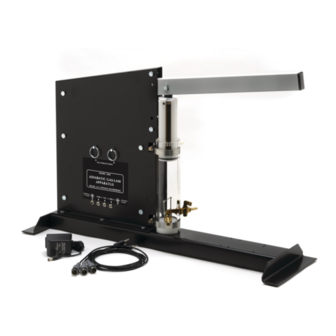Table of Contents
Advertisement
Quick Links
Adiabatic Gas Law Apparatus
Introduction
The Adiabatic Gas Law Apparatus allows the user to investigate
the compression and expansion of gases. Sensitive transducers
in the apparatus measure the pressure, temperature, and
volume of the gas almost simultaneously as the gas is
compressed or expanded rapidly under nearly adiabatic
conditions, or slowly under isothermal conditions. Analog signals
from the sensors can be monitored by PASCO Capstone data
collection software using the 850 Universal Interface (UI-5000).
The interface acts as a three channel storage oscilloscope while
Capstone plots graphs of pressure, temperature, and volume.
The program can also be used to plot a graph of pressure
versus volume and integrate under the curve to find the work
done on the gas.
Equipment
Included equipment:
Power and signal output jacks
Connect the power adapter and signal cables to these
jacks during the experiment.
Lever arm
Can be moved up and down to compress or expand the
gas in the cylinder.
Cylinder
Contains a piston which moves up and down in response to
the lever arm, compressing or expanding the trapped gas.
Power adapter (9 V DC @ 1 A)
Can be plugged into any standard power outlet.
3× signal cables
3.5 mm phone plug-to-5-pin DIN plug.
Required equipment:
• PASCO Capstone data collection software
• 850 Universal Interface (UI-5000)
Get the software
Collecting data from the apparatus requires PASCO Capstone
software. We offer a free trial of Capstone for Windows and Mac.
To get the software, go to pasco.com/downloads.
If you have installed the software previously, check that you have
the latest update by opening the Help menu and clicking Check
for Updates.
Relevant equations
A process is considered adiabatic if no thermal energy enters or
leaves the system during the process. This would occur if the
system were perfectly thermally insulated, or if the process
occurred so rapidly that there could not be any heat transfer.
The following is a derivation of the relationship of the pressure
P, temperature T, and volume V when n moles of a confined
ideal gas are adiabatically compressed or expanded.
For an adiabatic process, the first law of thermodynamics can be
stated as:
where C
is the molar specific heat at constant volume and R is
V
the universal gas constant (approximately 8.314 J/mol°K). For
any ideal gas, PV = nRT. Thus, taking the derivative of both
sides, we get PdV + VdP = nRdT. Solving this equation for dT,
we get:
Substituting this equation into our original one, we get:
where C
is the molar specific heat at constant pressure, which
P
is equal to C
+ R. The ratio of C
V
Using these results, we obtain:
From this, we can derive that:
This result is considered the standard Adiabatic Gas Law. From
this equation and the ideal gas law PV = nRT, we can find a
second form of this relationship:
Product Guide | 012-05110D
(TD-8565)
/C
is denoted as
(gamma).
P
V
1
Advertisement
Table of Contents

Summary of Contents for PASCO TD-8565
- Page 1 Analog signals The following is a derivation of the relationship of the pressure from the sensors can be monitored by PASCO Capstone data P, temperature T, and volume V when n moles of a confined collection software using the 850 Universal Interface (UI-5000).
- Page 2 Adiabatic Gas Law Apparatus | TD-8565 Another relationship that can be examined with this apparatus is IMPORTANT: The temperature sensor and the energy expended or work done on the gas in the process of commutator brush are extremely fragile. There compressing it adiabatically.
- Page 3 5. Plug the signal cable from the Volume output into Analog Input C of the 850 Universal Interface. Software setup 1. Start PASCO Capstone, then select Hardware Setup from the Tools palette. 2. Turn on the 850 Universal Interface and connect it to your computer via USB cable.
- Page 4 Adiabatic Gas Law Apparatus | TD-8565 Experiment: Measurement of work required to compress gases adiabatically Equipment needed Required equipment: • Adiabatic Gas Law Apparatus • 850 Universal Interface (UI-5000) • PASCO Capstone data collection software Optional equipment: • Monatomic, diatomic, and polyatomic gases...
- Page 5 Product Guide | 012-05110D Calculations 1. From your graphs and Capstone’s built-in analysis tools, determine the final pressure and temperature at the time the compression was completed. For temperature, extrapolate the best value possible from the graph, as you may not have a single clear value. 2.
- Page 6 PASCO scientific, is prohibited. Trademarks PASCO and PASCO scientific are trademarks or registered trademarks of PASCO scientific, in the United States and in other countries. All other brands, products, or service names are or may be trademarks or service marks of, and are used to identify, products or services of, their respective owners.
















Need help?
Do you have a question about the TD-8565 and is the answer not in the manual?
Questions and answers